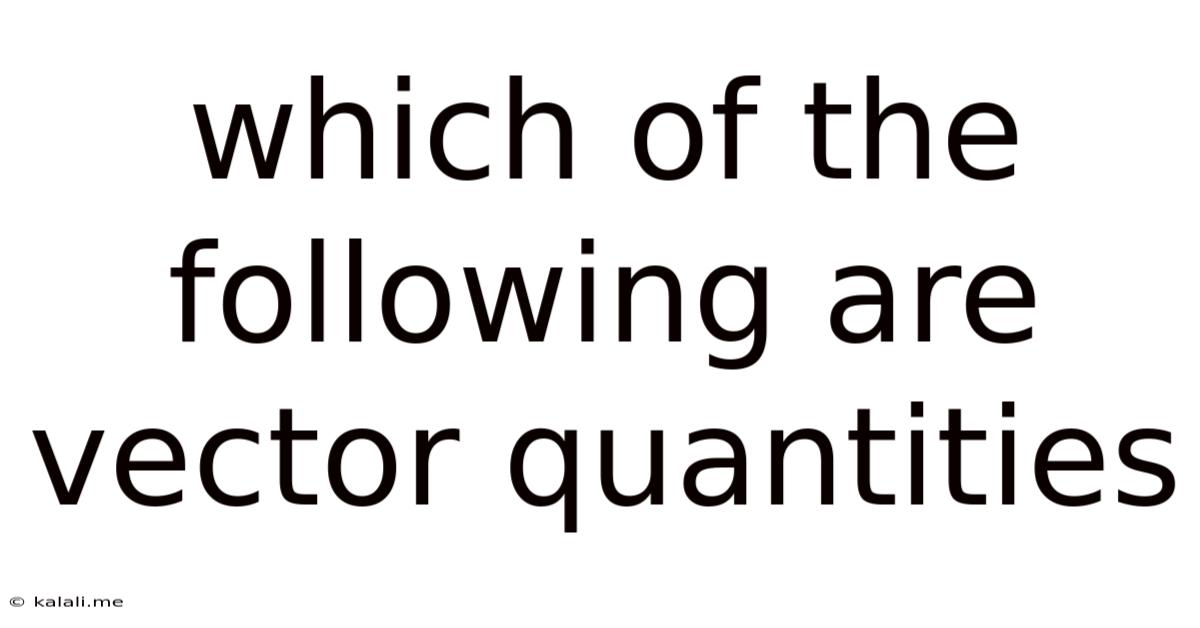Which Of The Following Are Vector Quantities
Kalali
Jun 11, 2025 · 3 min read

Table of Contents
Which of the Following are Vector Quantities? A Comprehensive Guide
Understanding the difference between scalar and vector quantities is crucial in physics and many other scientific fields. Scalars are quantities that have only magnitude (size), while vectors possess both magnitude and direction. This article will delve into identifying vector quantities from a given list, explaining the concept thoroughly and providing practical examples. This will equip you with the knowledge to confidently distinguish between these two fundamental types of physical quantities.
What are Vector Quantities?
Vector quantities are represented by arrows. The length of the arrow represents the magnitude (size) of the quantity, and the direction of the arrow represents the direction of the quantity. Think of it like navigating with a map and compass – you need both distance and direction to reach your destination. Examples include displacement, velocity, acceleration, force, momentum, and electric field.
Key Characteristics of Vectors:
- Magnitude: The size or amount of the quantity. For example, the speed of a car (scalar) is 60 mph, while its velocity (vector) might be 60 mph north.
- Direction: The orientation or path of the quantity. This is what differentiates vectors from scalars.
Identifying Vector Quantities: A Practical Approach
Let's consider a hypothetical list of quantities:
- Speed: This is a scalar quantity. It only tells us how fast something is moving, not in which direction.
- Velocity: This is a vector quantity. It specifies both the speed and the direction of motion (e.g., 50 km/h eastward).
- Distance: This is a scalar quantity, representing the total ground covered.
- Displacement: This is a vector quantity. It represents the change in position from a starting point to an ending point, including the direction.
- Mass: This is a scalar quantity. It measures the amount of matter in an object.
- Weight: This is a vector quantity. It represents the force of gravity acting on an object, having both magnitude and direction (downward).
- Temperature: This is a scalar quantity.
- Acceleration: This is a vector quantity. It describes the rate of change of velocity, including both magnitude and direction.
- Force: This is a vector quantity. It has both magnitude (strength) and direction.
- Energy: This is a scalar quantity. It represents the capacity to do work.
- Momentum: This is a vector quantity. It is the product of mass and velocity.
Common Mistakes to Avoid
A frequent error is confusing speed and velocity or distance and displacement. Remember:
- Speed vs. Velocity: Speed is how fast something moves; velocity is how fast and in what direction it moves.
- Distance vs. Displacement: Distance is the total path traveled; displacement is the straight-line distance from the starting point to the ending point, considering direction.
Conclusion
Accurately identifying vector quantities is vital for solving physics problems and understanding the world around us. By understanding the key characteristics of vectors – magnitude and direction – and by practicing with examples, you can confidently distinguish between scalars and vectors in any given scenario. Remember to always consider both the size and the direction when determining whether a quantity is a vector. This understanding forms a solid foundation for more advanced concepts in physics and related fields.
Latest Posts
Latest Posts
-
How Many Pounds Is A Bushel Of Peanuts
Jul 01, 2025
-
How Many Pounds Are In 32 Ounces
Jul 01, 2025
-
What Year Would I Be Born If I Was 21
Jul 01, 2025
-
How Many Minutes Are In 40 Hours
Jul 01, 2025
-
How Many Cups Are In 16 Oz Of Sour Cream
Jul 01, 2025
Related Post
Thank you for visiting our website which covers about Which Of The Following Are Vector Quantities . We hope the information provided has been useful to you. Feel free to contact us if you have any questions or need further assistance. See you next time and don't miss to bookmark.